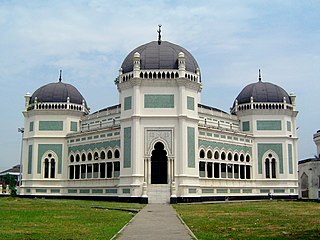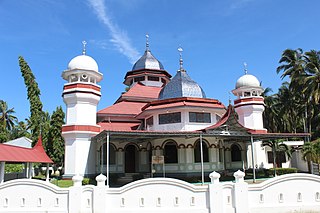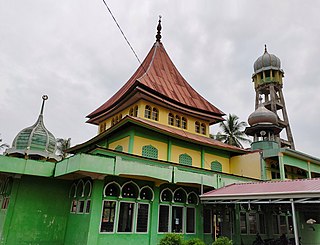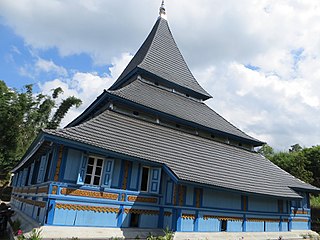
West Sumatra is a province of Indonesia. It is on the west coast of the island of Sumatra and includes the Mentawai Islands off that coast. West Sumatra borders the Indian Ocean to the west, as well as the provinces of North Sumatra to the north, Riau to the northeast, Jambi to the southeast, and Bengkulu to the south. The province has an area of 42,119.54 km2 (16,262.45 sq mi), or about the same size as Switzerland, with a population of 5,534,472 at the 2020 census. The official estimate at mid 2023 was 5,757,210. The province is subdivided into twelve regencies and seven cities. It has relatively more cities than other provinces outside Java, although several of them are relatively low in population compared with cities elsewhere in Indonesia. Padang is the province's capital and largest city.

Padang is the capital and largest city of the Indonesian province of West Sumatra. It had a population of 833,562 at the 2010 Census and 909,040 at the 2020 Census; the official estimate as at mid 2023 was 942,938 - comprising 473,089 males and 469,849 females. It is the 16th most populous city in Indonesia and the most populous city on the west coast of Sumatra. The Padang metropolitan area is the third most populous metropolitan area in Sumatra with a population of over 1.7 million. Padang is widely known for its Minangkabau culture, cuisine, and sunset beaches.

Istiqlal Mosque in Jakarta, Indonesia is the largest mosque in Southeast Asia and the ninth largest mosque in the world in terms of worshipper capacity. Built to commemorate Indonesian independence, this national mosque of Indonesia was named "Istiqlal", an Arabic word for "independence". The mosque was opened to the public on 22 February 1978. Within Jakarta, the mosque is positioned next to Merdeka Square, the Jakarta Cathedral (Catholic), and also of the Immanuel Church (Reformed).

Baiturrahman Grand Mosque is a mosque located in Banda Aceh, Aceh, Indonesia. The Baiturrahman Grand Mosque is a symbol of religion, culture, spirit, strength, struggle, and nationalism of the Acehnese people. The mosque is a landmark in Banda Aceh and has survived the 2004 Indian Ocean earthquake and tsunami.

Grand Mosque of Medan or Masjid Raya Al-Mashun is a mosque located in Medan, Indonesia. The mosque was built in the year 1906 and completed in 1909. In beginning of its establishment, the mosque was a part of the Maimun palace complex. Its architectural style combines Middle Eastern, Indian, and Spanish elements. The mosque has an octagonal shape and has wings to the south, east, north, and west.

Grand Mosque of West Sumatra is a mosque in Padang, West Sumatra, Indonesia. It is the largest mosque in West Sumatra and the second-largest mosque in Sumatra. It is located in Padang Utara Subdistrict, Padang, West Sumatra. The Grand Mosque of West Sumatra is located within a complex of 40,345 square meters at the intersection of Jalan Khatib Sulaiman and Jalan Ahmad Dahlan.

Andalas Grand Mosque is a mosque located in Andaleh Street no.56, Andaleh, East Padang district, Padang, West Sumatra, Indonesia. The mosque consists of a green building with two floors which has area of 1,200 m2, and a minaret in the southeast and an entrance gate in the south.

The Teluk Bayur Grand Mosque, also known as Surau Ateh, is an old mosque in Indonesia which is located near the Port of Teluk Bayur, South Padang district, Padang, West Sumatra. Although the mosque was previously a surau which was recorded to have stood since the 17th century, the building that stands at its current location was built during the Dutch colonization around the 19th century.

The Syekh Burhanuddin Grand Mosque is one of the oldest mosques as well as a cultural heritage in West Sumatra, Indonesia. The mosque is located in Nagari Ulakan, Ulakan Tapakis sub-district, Padang Pariaman district of West Sumatra.

Balai Gadang Mungo Grand Mosque is an old mosque in Indonesia, located in Jorong Balai Gadang Bawah, Nagari Mungo, Luhak District, Lima Puluh Kota Regency, West Sumatra. The mosque was built in 1914, making it one of the oldest mosques in Indonesia, and the oldest mosque in Nagari Mungo.

Rao Rao Mosque is one of the oldest mosques in Indonesia located in Nagari Rao Rao, Tarab River, Tanah Datar Regency, West Sumatra. It is located on the road from Batusangkar bound to Bukittinggi, precisely in Rao Rao. This mosque of Minangkabau and Persian architecture was built in 1908 with a roof made from fibers before being changed to zinc.

The Bingkudu Mosque is one of the oldest mosques in Indonesia. It was founded by the Padri in the wake of the Padri War in West Sumatra in 1823. This mosque with typical Minangkabau style architecture is located in Jorong Bingkudu, Nagari Canduang Koto Laweh, Canduang District, Agam Regency, West Sumatra. When it was first built, the building of the mosque was made of wood on its floor, pole, and wall.

Koto Baru Grand Mosque is one of the oldest mosques in Indonesia located in Koto Baru Nagari, Sungai Pagu District, South Solok Regency, West Sumatra.

The Tuo Kayu Jao Mosque is an old mosque in Indonesia that is located in Jorong Kayu Jao, Batang Barus Nagari, Gunung Talang District, Solok Regency, West Sumatra. The existence of the mosque was already recorded in 1599, making it the oldest mosque in Solok Regency and among the oldest surviving mosques in Indonesia.

The Tuo Koto Nan Ampek Mosque, also known as Gadang Balai Nan Duo Mosque is one of the oldest mosques in Indonesia located in Koto Nan Ampek Nagari, now administratively included into the area of Balai Nan Duo village, West Payakumbuh District, city of Payakumbuh, West Sumatera. The Minangkabau architecture is thought to have been built in 1840 which was originally covered with fiber roofs before being replaced with zinc. Currently, other than being used for Muslim worship activities, this single-level mosque is also used by the surrounding community as a means of religious education.

The Nurul Huda Mosque is one of the oldest mosques in Indonesia, located in Baringin District, Sawahlunto, West Sumatra. The mosque, built during the Dutch occupation, has a rectangular building with a tower blending into the main building. Currently, in addition to a function as a place of worship for Muslims, this two-story mosque is also used as a means of religious education for the surrounding community.

The Nurul Iman Mosque is a mosque located at the corner of Jalan Imam Bonjol and Jalan Muhammad Thamrin in Padang, Indonesia. The mosque was built by the Indonesian National Armed Forces and the national government, as a gesture of apology following a West Sumatran rebellion in 1960.

Grand Mosque of Kubang Putih is an early 19th-century mosque located in the town of Kubang Putiah, West Sumatra, Indonesia. The mosque is designated as a cultural heritage object along with several other old mosques in West Sumatra, such as Bingkudu Mosque in Agam, Rao Rao Mosque in Tanah Datar, and the Ganting Grand Mosque in Padang.

Darussalam Grand Mosque, Palangka Raya is one of the mosques in Central Kalimantan, Indonesia. This grand mosque is located on George Obos Street in the district of Jekan Raya, Palangka Raya. This mosque is situated within the Islamic Center area of Palangka Raya. This grand mosque is also one of the most important icons of the capital city of Central Kalimantan province.































